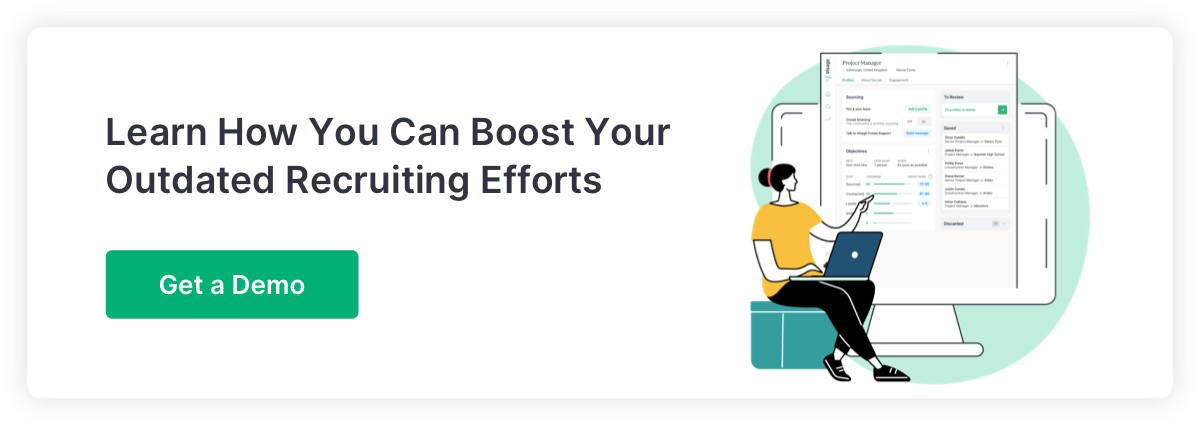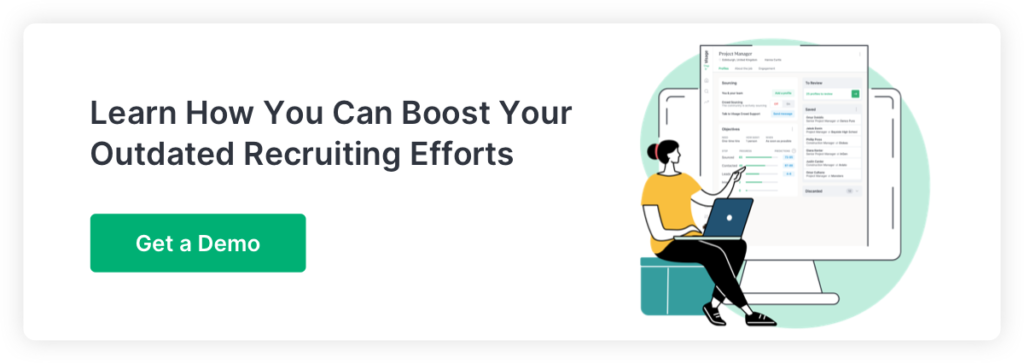Love it or hate it, ChatGPT is here to stay. Learning to use it proficiently, however, can make a savvy recruiter’s life much easier with efficient responses for better, highly targeted results.
This generative AI assistant can enhance the entire recruitment cycle: streamlining the processes, enhancing candidate engagement, and surfacing useful insights for better hiring decisions. It makes sense to get the most out of it. To get started, we’ll explore the top 16 ChatGPT prompts we think every recruiter should be using.
ChatGPT And The Recruitment Cycle
When you use ChatGPT, it doesn’t mean you’re putting your brain on hold. You’ll still need your human skills and intelligence to understand its context and limitations so you can get the right results.
ChatGPT effectively takes a lot of the gruntwork out of hiring, but that’s not all. It’s also great for ideation, analysis, troubleshooting, productivity, coding and tech support, as well as automating a whole ton of tedious processes. Click on the links below to jump ahead on the page.
In recruitment, you can use ChatGPT to:
- Generate job descriptions.
- Source candidates.
- Screen candidates.
- Personalize candidate outreach.
- Prepare for interviews.
- Gain insight using predictive analytics.
- Enhance diversity & inclusion.
The trick is to use the right prompts to get the best results.
Quick Definition: Prompt
For ChatGPT purposes, a prompt refers to a specific input or question users enter into ChatGPT that guides its response.
ChatGPT: Using Prompts
It’s important to use a quality prompt to get a quality output. A prompt should set the context, provide relevant details, establish parameters, and define the task or query.
- Context: Provide background information to ensure ChatGPT understands the topic or scenario.
- Clarity: Clearly specify what kind of response is expected.
- Details: Include necessary specifics, such as keywords, instructions, tone, word count, or other constraints to narrow the responses.
- Goal: Define your purpose or desired outcome.
Generating Job Descriptions
Using ChatGPT to write job descriptions can be a helpful way to research and generate compelling and accurate job postings efficiently. You can optimize an existing job description, or write one from scratch. Don’t forget to include context, clarity, details, and your goal.
Prompt #1: Researching a Job
Prompt Example: “List the ideal traits of a successful ecommerce customer service representative in less than 800 words.”
Prompt #2: Optimizing an Existing Job Description
Prompt Example: “Rewrite this job description [insert job description] to include the following keywords [list keywords] in a friendly, informal tone.”
Prompt #3: Creating a Job Description
Prompt Example: “Write a compelling and attractive job description for a Data Analyst position at [your company] that includes these key responsibilities and qualifications: [list of responsibilities and qualifications]. In addition, include information about our company culture and values, and emphasize that we especially promote individual autonomy.”
Sourcing Candidates
ChatGPT can help with talent sourcing challenges by providing guidance about where to source for specific talent types, cutting hours of research time down to seconds. Although some information will be out of date, you’ll get useful ideas about the kinds of places to source. It’ll even write you Boolean search terms for a detailed search.
Prompt #4: Finding Talent Sources
Prompt Example: “List 10 regenerative energy forums in the US and Germany.”
Prompt #5: Excluding Common Talent Sources
Prompt Example: “Where is the best place to source a biochemical engineer that isn’t LinkedIn?”
Prompt #5: Writing Boolean searches
Prompt Example: “Write a Boolean search query to source for a Biochemical Engineer in Portland, Oregon, who has at least 5 years of experience in the healthcare sector.”
Screening Candidates
Use ChatGPT to compare candidates based on your desired criteria, such as qualifications, length of experience, or sector experience, efficiently filtering and ranking candidates based on their suitability for the position.
Prompt #6: Compare two candidates
Prompt Example: “Which of these two candidates would be better at managing a dispersed team? [List candidate profile/ experience/skills].”
Prompt #7: Rank candidates
Prompt Example: “Rank the following 8 candidates based on their qualifications for this job description. [Insert job description] [Insert candidate resumes]”
Prompt #8: Summarize candidates
Prompt Example: “Write a short description of each candidate to include as a summary to the hiring manager. Keep each summary under 500 words. [insert candidate resumes]”
Personalized Candidate Communication
Outreach
Although “personalized” and “AI” seem to be opposing terms, it is possible to establish and maintain human connection using ChatGPT, and do so at scale. To support personalization, ChatGPT can:
- Analyze candidate profiles to identify their preferences, interests, and aspirations.
- Match these with the unique aspects of the company and the role.
- Create an outreach email that demonstrates an understanding of each candidate and how the role/company would be a perfect fit for them.
- Use the most engaging tone and voice for candidate communications, consistent with the employer brand.
Prompt #9: Candidate Outreach
Prompt Example: “Create an outreach email to this candidate [insert candidate resume] for a Product Manager position. Please structure the email to catch their interest and highlight the benefits of joining this company and use a warm and friendly writing tone.”
Engaging Rejection Emails
What about those people who didn’t make the shortlist?
Keep them engaged and positive about you with a kind and supportive “rejection” email that’ll make them happy to remain in your talent pipeline, ready for another opportunity:
Prompt #10: Creating Warm Rejections
Prompt Example: “Write a warm, friendly, and slightly informal email template to inform candidates that they were not selected for a specific job position. The message should extend appreciation for the candidate’s application and highlight that their skills and experience are impressive before expressing a desire to keep the candidate’s information on file for future opportunities. It should conclude by encouraging the candidate to apply for other roles that may suit their qualifications.”
Interview Preparation
Using ChatGPT to prep for interviews is a powerful way to streamline your process. Use it to generate potential interview questions tailored to the job role, company culture, and required skills. You can also ask it for insight into industry trends, behavioral interview techniques, and best practices for assessing candidates.
With ChatGPT’s help, recruiters can walk into interviews well-prepared with a deeper understanding of each candidate’s background. Asking thoughtful questions can lead to more insightful conversations and better hiring decisions.
Prompt #11: Creating Behavioral Questions
Prompt Example: “List at least 7 behavioral interview questions for a Customer Service Manager position. Focus these questions on assessing a candidate’s problem-solving skills, ability to handle difficult customers, and experience in managing teams.”
Prompt #12: Creating Technical Questions
Prompt Example: “I need help preparing to conduct a technical interview for a DevOps Engineer. What are some key technical questions I should ask to evaluate the candidate’s expertise in cloud infrastructure, automation tools, and CI/CD pipelines?”
Prompt #13: Assessing Cultural Fit
Prompt Example: “Prepare a list of cultural fit interview questions to gauge a candidate’s alignment with our company values and work environment.”
Predictive Analytics
Use ChatGPT to create predictive models on the effectiveness of your recruitment process by feeding it relevant recruitment metrics, such as time-to-hire, candidate sourcing channels, applicant demographics, and hiring outcomes.
ChatGPT can help identify patterns, correlations, and potential bottlenecks in your recruitment process, which will help you improve what you do and how you’re doing it.
Prompt #14: Identifying Best Sources
Prompt Example: “Which of these candidate sourcing channels is likely to yield the highest quality hires in the future [insert data]?”
Prompt #15: Assessing Time-to-hire
Prompt Example: “We filled open roles in an average of 45 days last year. Determine if this is a good average, compared to other companies’ average time-to-fill.”
Diversity & Inclusion
Using ChatGPT in your recruitment workflow offers several benefits in support of your DEI goals, including:
- Unbiased screening. Screens resumes without being influenced by a candidate’s name, gender, or ethnicity.
- Broader candidate search. Finds talent from underrepresented groups.
- Inclusive language. Analyzes job descriptions and communications for exclusive language and suggests revisions to make them more appealing to diverse audiences.
Prompt #16: Correct Bias in Job Descriptions
Prompt Example: “How can we improve our job descriptions to attract a more diverse pool of candidates? Please provide specific examples and suggestions for inclusive language and practices.”
ChatGPT Recruiting Prompts: Get Your Guide
This is just a small sampling of the kinds of prompts you can use at every level of your recruiting cycle. Want more? Download our essential guide to harness ChatGPT’s capabilities so you can connect with candidates like never before.

Director of Sourcing Operations at Visage, Evelyn has experience in agency, RPO, and in-house roles spanning 12 years in the recruitment industry. Evelyn has built and oversees a 4000-member global freelance sourcing community. Every Christmas in Ireland, she enjoys putting up her THREE Christmas trees.

